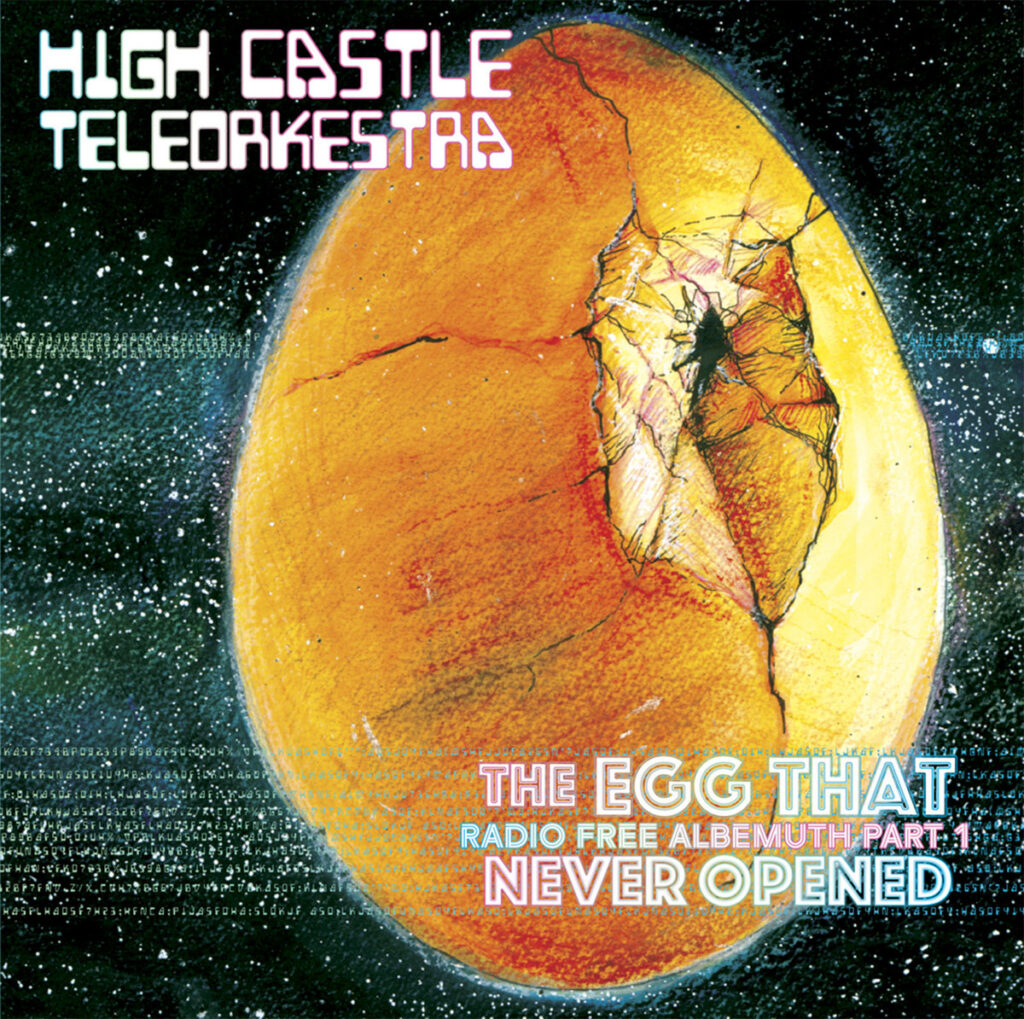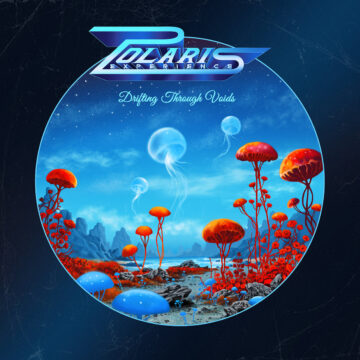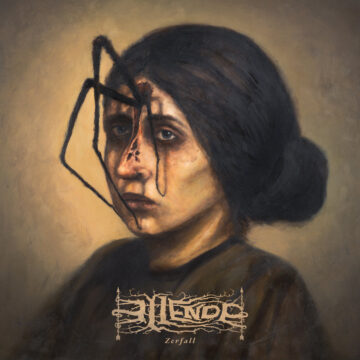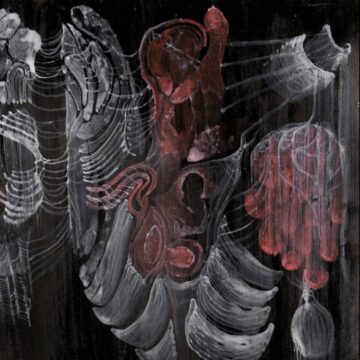Review: High Castle Teleorkestra – The Egg That Never Opened

Style: Experimental Progressive Rock (clean vocals)
Review by: Will
Country: US-CO
Release date: 17 June 2022
Radio Free Albemuth is a science fiction novella from the 1970’s by Philip K. Dick. It imagines a dystopian, alternate USA where a corrupt Republican President (Ferris F. Freemont) rises to prominance on a pro-gun anti-LGBT+ platform and later facilitates the erosion of human rights and civil liberties by creating outlandish conspiracy theories about his political enemies and forging close ties with far-right populist movements (whew! Good job none of that actually happened).
High Castle Teleorkestra (HCT) is a collective of musicians who collaborated remotely on their debut album The Egg That Never Opened; Radio Free Albemuth Pt 1. Possibly taking their name from another Philip K. Dick novel: The Man in the High Castle, HCT re-tell Dick’s Radio Free Albemuth through an often cacophonous amalgamation of jazz, rock, metal, 50s surf-rock, do-wop and Eastern European folk music.
Dick’s story, and HCT’s album follows the resistance to President Freemont’s regime, which is aided by an extraterrestrial intelligence called ValisystemA (or Valis) which exists in the form of a satellite orbiting Earth. Valis is able to communicate with the main characters through visions and dreams by transmitting a narrow-beam radio signal from orbit. The album follows the story beats by taking its track titles from lines in the book as well as through a sonic exploration of the tones and themes of the story.
HCT offer a cinematic and immersive take on their re-telling of the novel: They interweave diegetic sound from the world in the book: German marching songs that are hummed by a character or snippets of music that are mentioned in the book such as “If I Knew You Were Coming I’d Have Baked a Cake”. Eastern-European folk music reflects the folk record label a character works for, etc, etc. This gives the listener a real sense of being part of the universe, among the coffee shops of Berkley and the dusty streets of Orange County, it’s a beautiful and energetic way of adapting a literary work into an album.
But HCT go further than that and almost seem to role-play as an in-universe band, collaborating with Valis themselves by sending subliminal messages in their music to undermine President Freemont’s regime. This is brought to life in HCT’s music video for “Mutual Hazard” which imagines the band’s virtual meetings being under surveillance by an oppressive regime. The commitment to story and the universe is one of the most captivating things about the band, reading Radio Free Albemuth and listening along to The Egg That Never Opened adds so much depth and flavour and reveals this album as a real labour of love.
As a band HCT comprises six ‘core’ members along with a monstrous seventeen guest artists, giving the band access to a frightening array of musical talent and a range of instruments from the conventional guitars, bass and drums to the less-conventional saxophones, cellos, violins and whatever-the-hell a ‘weirdly phaser’ is. Throughout the album, HCT very much takes a maximalist approach to sound through layering of tracks, jarring genre switches, employing unusual time-signatures and melding dissonant tones together. “Ich Bin’s” for example, creates an unholy amalgam of lilting accordion, heavily distorted guitar and what sounds like a theruman (but could, of course be the elusive ‘weirdly phaser’) to describe a character having a mystical experience. “Mutual Hazard” smashes together frantic European Folk, with metal and logic-defying time signatures.
The production of The Egg that Never Opened is also worth mentioning – it is undoubtedly a challenge to balance such a huge number of instruments across a track. This is done beautifully on this album with the mixes mastered and run to ¼ inch tape before digitisation (staying true to the recording mediums of the book’s time period). HCT have also managed to have their cake and eat it with a double CD release. CD 1 has the “official” tracks and mixes whereas CD 2 has over 40 bonus tracks and alternative mixes. This is a smart way to create a sprawling project with multiple artists and multiple visions and clearly a lot of love for the subject material and to also create an album with a 48 minute runtime. The tracks themselves, though overstuffed with instruments and layers, avoid feeling too cumbersome and self-indulgent as a result.
However, for all its musicianship and clever tricks, there is little memorable about The Egg that Never Opened. There are a few musical pieces that reoccur at various points across the album but overall, with so much going on in a track, there’s little for the listener to really grab hold of and digest. The album very much rewards repeat listenings for this reason but it ultimately feels like an intellectual exercise in dissecting a very well-constructed experimental album rather than listening to a piece of music that connects to the listener emotionally. There’s so much ‘head’ here, it’s missing the ‘heart’. Perhaps this is a fault of the way the band is formed: it is likely difficult for a group of musicians who are meeting remotely to jam in the same way a conventional band would – it is often through those organic sessions that the emotional core of a track can be established.
Ultimately, as is so often the case with this style of music, whether people will like The Egg that Never Opened will depend on their attitude to avant-garde and experimental music. Some listeners might find the jarring twists and lack of emotional impact difficult to latch onto while others may love diving into its complexity and revel in the technical musical talent. It is, however, certainly worth the time to spin up. It is also worth bearing in mind that this album shines so much brighter if you are familiar with Dick’s novella. So if you’re up for an interesting read and an undoubtedly exciting album (whether you connect with it or not), then this might well be something for you.
Recommended tracks: The Egg That Never Opened, At Last He Will, Mutual Hazard
Recommended for fans of: Mr. Bungle, Bonzo Dog Doo Dah Band
You may also like: City Weezle,
Final verdict: 7/10
Related links: Bandcamp | Spotify | Official Website | YouTube | Facebook | Instagram | Metal-Archives page
Label: Art As Catharsis / FALSExIDOL Records – Bandcamp | Website | Facebook
High Castle Teleorkestra is (deep breath):
Chris Bogen – guitars, keyboards, lap steel (1,4,7,9), melodica (2), noise collages (1, 5, 8, 9)
Stian Carstensen – accordion, pedal steel (1,2,4,9), vocals (1), rhythm guitar (10)
Timba Harris – violin, viola
Bär McKinnon – tenor sax, flute, clarinet, vocals (3,4), keyboards
Dave Murray – drums (1, 2, 3, 5, 10)
Tim Smolens – standup bass, electric basses, cello, vocals (1, 4, 7), grand piano, keyboard
With Guests:
Sai Boag – Synth (3)
Danny Heifetz – drums, vibraphone (4)
Pieta Hextall – bassoon (4)
Luke Kirley – trombone (1), tuba (1, 2)
Giani Lincan – cimbalom (10)
Monica Ludekens – french horn (4)
Vinnie “Saturn” Metts – drums (9), vibraphone (8)
Caitlin O’Connor – vocals (1, 3, 5, 6, 7)
George “GoPo” Phillips – noise collage: alligator people (8)
Rory Reagan – drums (2, 6, 7, 8)
Federico Randazzo – tenor saxophone, flute, clarinet (1, 7)
Adam Stacey – accordion (7)
Jason Usry – noise collage: weirdy phaser (8)
Jarle Vespestad – extra drums and percussion (10)
Antonie Veskovski – vibraphone (8)
John Whooley – tenor and alto saxophones (10)
Georgi Yanev – lead violin (10)



0 Comments